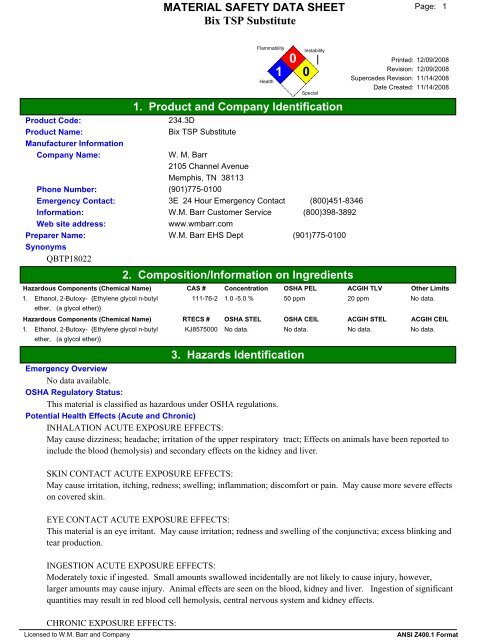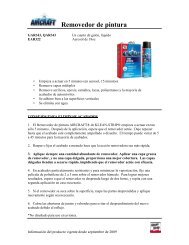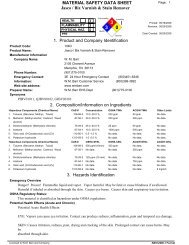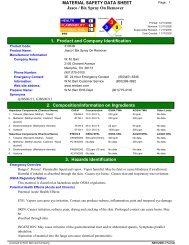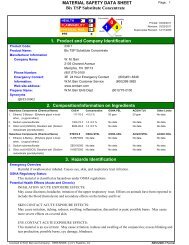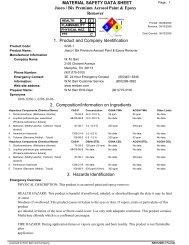Bix TSP Substitute MATERIAL SAFETY DATA SHEET 1 ... - WM Barr
Bix TSP Substitute MATERIAL SAFETY DATA SHEET 1 ... - WM Barr
Bix TSP Substitute MATERIAL SAFETY DATA SHEET 1 ... - WM Barr
Create successful ePaper yourself
Turn your PDF publications into a flip-book with our unique Google optimized e-Paper software.
<strong>MATERIAL</strong> <strong>SAFETY</strong> <strong>DATA</strong> <strong>SHEET</strong><br />
<strong>Bix</strong> <strong>TSP</strong> <strong>Substitute</strong><br />
Flammability<br />
Health<br />
1<br />
0<br />
Instability<br />
0<br />
Special<br />
1. Product and Company Identification<br />
Product Code: 234.3D<br />
Product Name:<br />
Manufacturer Information<br />
<strong>Bix</strong> <strong>TSP</strong> <strong>Substitute</strong><br />
Company Name: W. M. <strong>Barr</strong><br />
2105 Channel Avenue<br />
Memphis, TN 38113<br />
Phone Number: (901)775-0100<br />
Emergency Contact: 3E 24 Hour Emergency Contact (800)451-8346<br />
Information: W.M. <strong>Barr</strong> Customer Service (800)398-3892<br />
Web site address: www.wmbarr.com<br />
Preparer Name:<br />
Synonyms<br />
QBTP18022<br />
W.M. <strong>Barr</strong> EHS Dept (901)775-0100<br />
Hazardous Components (Chemical Name)<br />
1. Ethanol, 2-Butoxy- {Ethylene glycol n-butyl<br />
ether, (a glycol ether)}<br />
Hazardous Components (Chemical Name)<br />
1. Ethanol, 2-Butoxy- {Ethylene glycol n-butyl<br />
ether, (a glycol ether)}<br />
2. Composition/Information on Ingredients<br />
CAS #<br />
111-76-2<br />
RTECS #<br />
KJ8575000<br />
Page:<br />
1<br />
Printed: 12/09/2008<br />
Revision: 12/09/2008<br />
Supercedes Revision: 11/14/2008<br />
Date Created: 11/14/2008<br />
Concentration OSHA PEL ACGIH TLV Other Limits<br />
1.0 -5.0 % 50 ppm 20 ppm<br />
No data.<br />
OSHA STEL OSHA CEIL ACGIH STEL ACGIH CEIL<br />
No data.<br />
No data. No data.<br />
No data.<br />
3. Hazards Identification<br />
Emergency Overview<br />
No data available.<br />
OSHA Regulatory Status:<br />
This material is classified as hazardous under OSHA regulations.<br />
Potential Health Effects (Acute and Chronic)<br />
INHALATION ACUTE EXPOSURE EFFECTS:<br />
May cause dizziness; headache; irritation of the upper respiratory tract; Effects on animals have been reported to<br />
include the blood (hemolysis) and secondary effects on the kidney and liver.<br />
SKIN CONTACT ACUTE EXPOSURE EFFECTS:<br />
May cause irritation, itching, redness; swelling; inflammation; discomfort or pain. May cause more severe effects<br />
on covered skin.<br />
EYE CONTACT ACUTE EXPOSURE EFFECTS:<br />
This material is an eye irritant. May cause irritation; redness and swelling of the conjunctiva; excess blinking and<br />
tear production.<br />
INGESTION ACUTE EXPOSURE EFFECTS:<br />
Moderately toxic if ingested. Small amounts swallowed incidentally are not likely to cause injury, however,<br />
larger amounts may cause injury. Animal effects are seen on the blood, kidney and liver. Ingestion of significant<br />
quantities may result in red blood cell hemolysis, central nervous system and kidney effects.<br />
CHRONIC EXPOSURE EFFECTS:<br />
Licensed to W.M. <strong>Barr</strong> and Company ANSI Z400.1 Format
<strong>MATERIAL</strong> <strong>SAFETY</strong> <strong>DATA</strong> <strong>SHEET</strong><br />
<strong>Bix</strong> <strong>TSP</strong> <strong>Substitute</strong><br />
Page:<br />
Printed: 12/09/2008<br />
Revision: 12/09/2008<br />
Supercedes Revision: 11/14/2008<br />
Reports have associated repeated and prolonged overexposure to solvents with neurological and other<br />
physiological damage. May cause skin irritation; liver damage; kidney damage; blood disorders; eye irritation.<br />
Prolonged skin contact may cause redness; swelling and possible skin destruction.<br />
Signs and Symptoms Of Exposure<br />
See Potential Health Effects.<br />
Routes of Entry: Inhalation, Skin<br />
4. First Aid Measures<br />
Emergency and First Aid Procedures<br />
Skin:<br />
Remove contaminated clothing. Immediately wash skin thoroughly with large amounts of water and mild soap, if<br />
available. Seek medical attention if irritation develops or persists.<br />
Eyes:<br />
Immediately begin to flush eyes with water, remove any contact lens. Continue to flush the eyes for at least 15<br />
minutes. Seek medical attention.<br />
Inhalation:<br />
Remove to fresh air. If not breathing, give artificial respiration. If breathing is difficult, give oxygen. Get<br />
immediate medical attention.<br />
Ingestion:<br />
If swallowed, do NOT induce vomiting. Seek immediate medical attention. Call a physician or poison control<br />
center immediately. Never give anything by mouth to an unconscious person.<br />
5. Fire Fighting Measures<br />
Flash Pt: No data.<br />
Explosive Limits: LEL: No data. UEL: No data.<br />
Fire Fighting Instructions<br />
Use NIOSH/MSHA approved positive pressure self-contained breathing apparatus when any material is involved<br />
in a fire.<br />
Flammable Properties and Hazards<br />
Flashpoint: No flash to boiling. Will not burn.<br />
Hazardous Combustion Products<br />
Carbon dioxide, carbon monoxide<br />
Extinguishing Media<br />
Carbon dioxide, dry powder, or foam.<br />
Unsuitable Extinguishing Media<br />
None known.<br />
6. Accidental Release Measures<br />
Steps To Be Taken In Case Material Is Released Or Spilled<br />
Isolate the immediate area. Prevent unauthorized entry. Eliminate all sources of ignition in area and downwind of<br />
the spill area. Stay upwind, out of low areas, and ventilate closed spaces before entering. All equipment used<br />
when handling this product must be grounded or non-sparking. Do not touch or walk through spilled material.<br />
Stop leak if you can do so without risk. Prevent entry into waterways, sewers, or confined areas. A vapor<br />
suppressing foam may be used to reduce vapors. Absorb or cover with dry earth, sand, or other non-combustible<br />
material and transfer to compatible containers. For large spills, dike ahead of the spill.<br />
Licensed to W.M. <strong>Barr</strong> and Company ANSI Z400.1 Format<br />
2
<strong>MATERIAL</strong> <strong>SAFETY</strong> <strong>DATA</strong> <strong>SHEET</strong><br />
<strong>Bix</strong> <strong>TSP</strong> <strong>Substitute</strong><br />
7. Handling and Storage<br />
Page:<br />
Printed: 12/09/2008<br />
Revision: 12/09/2008<br />
Supercedes Revision: 11/14/2008<br />
Precautions To Be Taken in Handling<br />
Read carefully all cautions and directions on product label before use. Since empty container retains residue,<br />
follow all label warnings even after container is empty. Dispose of empty container according to all regulations.<br />
Do not reuse this container.<br />
Precautions To Be Taken in Storing<br />
Keep container tightly closed when not in use. Store in a cool, dry place. Do not store near flames or at elevated<br />
temperatures.<br />
8. Exposure Controls/Personal Protection<br />
Respiratory Equipment (Specify Type)<br />
A respiratory protection program that meets OSHA's 29 CFR 1910.134 and ANSI Z88.2 requirements must be<br />
followed whenever workplace conditions warrant a respirator's use.<br />
If the work area is not properly ventilated to keep airborne levels below their exposure limits, you must use a<br />
properly fitted and maintained NIOSH approved respirator for organic vapors. A dust mask does not provide<br />
protection against vapors.<br />
Eye Protection<br />
Safety glasses, chemical goggles, or face shields are recommended to safeguard against potential eye contact,<br />
irritation, or injury. Contact lenses should not be worn while working with chemicals.<br />
Protective Gloves<br />
Nitrile, neoprene, natural rubber<br />
Other Protective Clothing<br />
Various application methods can dictate use of additional protective safety equipment, such as impermeable<br />
aprons, etc., to minimize exposure.<br />
Engineering Controls (Ventilation etc.)<br />
Use process enclosures, local exhaust ventilation, or other engineering controls to control airborne levels below<br />
recommended exposure limits.<br />
Use only with adequate ventilation to prevent buildup of vapors. Do not use in areas where vapors can accumulate<br />
and concentrate, such as basements, bathrooms or small enclosed areas. Whenever possible, use outdoors in an<br />
open air area. If using indoors open all windows and doors and maintain a cross ventilation of moving fresh air<br />
across the work area. If strong odor is noticed or you experience slight dizziness, headache, nausea or<br />
eye-watering -- STOP -- ventilation is inadequate. Leave area immediately and move to fresh air.<br />
Work/Hygienic/Maintenance Practices<br />
Wash hands thoroughly after use and before eating, drinking, or smoking. Do not eat, drink, or smoke in the<br />
work area. Discard any clothing or other protective equipment that cannot be decontaminated.<br />
9. Physical and Chemical Properties<br />
Physical States: [ ] Gas [ X ] Liquid [ ] Solid<br />
Melting Point: ~ 32.00 F<br />
Boiling Point: ~ 212.00 F<br />
Autoignition Pt: No data.<br />
Flash Pt: No data.<br />
Licensed to W.M. <strong>Barr</strong> and Company ANSI Z400.1 Format<br />
3
<strong>MATERIAL</strong> <strong>SAFETY</strong> <strong>DATA</strong> <strong>SHEET</strong><br />
<strong>Bix</strong> <strong>TSP</strong> <strong>Substitute</strong><br />
Explosive Limits: LEL: No data. UEL: No data.<br />
Specific Gravity (Water = 1): No data.<br />
Density: 8.565 LB/GL<br />
Vapor Pressure (vs. Air or mm Hg): > 1 MM HG<br />
Vapor Density (vs. Air = 1): No data.<br />
Evaporation Rate (vs Butyl<br />
Acetate=1):<br />
< 1<br />
Solubility in Water: Complete<br />
Percent Volatile: 98.0 % by weight.<br />
VOC / Volume: 1.4000 % WT<br />
Corrosion Rate: No data.<br />
pH:<br />
Appearance and Odor<br />
Blue, Free and Clear<br />
12.25 - 13.0<br />
10. Stability and Reactivity<br />
Stability: Unstable [ ] Stable [ X ]<br />
Conditions To Avoid - Instability<br />
No data available.<br />
Incompatibility - Materials To Avoid<br />
Strong oxidizers and acids.<br />
Hazardous Decomposition Or Byproducts<br />
Carbon dioxide and carbon monoxide<br />
Hazardous Polymerization: Will occur [ ] Will not occur [ X ]<br />
Conditions To Avoid - Hazardous Polymerization<br />
No data available.<br />
2-Butoxyethanol:<br />
LD50 Rat oral 1.48 g/kg<br />
LD50 Mouse oral 1.2 g/kg<br />
LD50 Rabbit oral 0.32 g/kg<br />
LD50 Guinea pig oral 1.2 g/kg<br />
LD50 Rabbit dermal 400 mg/kg<br />
LD50 Rat (male) oral 560-3000 mg/kg<br />
LD50 Mouse (male) oral 1519 mg/kg (fasting)<br />
LC50 Rat (male) inhalation 486 ppm/4 hr<br />
LC50 Rat (female) inhalation 450 ppm/4 hr<br />
LC50 Mouse inhalation 700 ppm/7 hr<br />
LD50 Rat (female) ip 550 mg/kg<br />
LD50 Rat (female) iv 340 mg/kg<br />
LD50 Mouse iv 1130 mg/kg<br />
LD50 Rabbit (male) iv 280 mg/kg<br />
Carcinogenicity/Other Information<br />
No data available.<br />
Hazardous Components (Chemical Name)<br />
1. Ethanol, 2-Butoxy- {Ethylene glycol n-butyl<br />
ether, (a glycol ether)}<br />
11. Toxicological Information<br />
CAS #<br />
111-76-2<br />
Page:<br />
Printed: 12/09/2008<br />
Revision: 12/09/2008<br />
Supercedes Revision: 11/14/2008<br />
NTP IARC ACGIH OSHA<br />
Possible<br />
2B A3<br />
No<br />
Licensed to W.M. <strong>Barr</strong> and Company ANSI Z400.1 Format<br />
4
No data available.<br />
<strong>MATERIAL</strong> <strong>SAFETY</strong> <strong>DATA</strong> <strong>SHEET</strong><br />
<strong>Bix</strong> <strong>TSP</strong> <strong>Substitute</strong><br />
12. Ecological Information<br />
13. Disposal Considerations<br />
Waste Disposal Method<br />
Dispose of in accordance with local, state, and federal laws.<br />
14. Transport Information<br />
LAND TRANSPORT (US DOT)<br />
DOT Proper Shipping Name CONSUMER COMMODITY, ORM-D<br />
Additional Transport Information<br />
For D.O.T. information, contact W.M. <strong>Barr</strong> Technical Services at 1-800-398-3892.<br />
Page:<br />
Printed: 12/09/2008<br />
Revision: 12/09/2008<br />
Supercedes Revision: 11/14/2008<br />
The supplier may apply one of the following exceptions: Combustible Liquid, Consumer Commodity, Limited<br />
Quantity, Viscous Liquid, Does Not Sustain Combustion, or others, as allowed under 49CFR Hazmat<br />
Regulations. Please consult 49CFR Subchapter C to ensure that subsequent shipments comply with these<br />
exceptions.<br />
US EPA SARA Title III<br />
Hazardous Components (Chemical Name)<br />
1. Ethanol, 2-Butoxy- {Ethylene glycol n-butyl<br />
ether, (a glycol ether)}<br />
US EPA CAA, CWA, TSCA<br />
Hazardous Components (Chemical Name)<br />
1. Ethanol, 2-Butoxy- {Ethylene glycol n-butyl<br />
ether, (a glycol ether)}<br />
15. Regulatory Information<br />
CAS #<br />
111-76-2<br />
CAS #<br />
111-76-2<br />
Sec.302 (EHS) Sec.304 RQ Sec.313 (TRI) Sec.110<br />
No<br />
No Yes-Cat. N230 No<br />
EPA CAA EPA CWA NPDES EPA TSCA CA PROP 65<br />
HAP<br />
No Inventory<br />
No<br />
SARA (Superfund Amendments and<br />
Reauthorization Act of 1986) Lists:<br />
Sec.302: EPA SARA Title III Section 302 Extremely Hazardous Chemical with TPQ. * indicates 10000<br />
LB TPQ if not volatile.<br />
Sec.304: EPA SARA Title III Section 304: CERCLA Reportable + Sec.302 with Reportable Quantity. **<br />
indicates statutory RQ.<br />
Sec.313: EPA SARA Title III Section 313 Toxic Release Inventory. Note: -Cat indicates a member of a<br />
chemical category.<br />
Sec.110:<br />
TSCA (Toxic Substances Control<br />
Act) Lists:<br />
EPA SARA 110 Superfund Site Priority Contaminant List<br />
Inventory: Chemical Listed in the TSCA Inventory.<br />
5A(2): Chemical Subject to Significant New Rules (SNURS)<br />
6A: Commercial Chemical Control Rules<br />
8A: Toxic Substances Subject To Information Rules on Production<br />
8A CAIR: Comprehensive Assessment Information Rules - (CAIR)<br />
8A PAIR: Preliminary Assessment Information Rules - (PAIR)<br />
8C: Records of Allegations of Significant Adverse Reactions<br />
8D: Health and Safety Data Reporting Rules<br />
8D TERM: Health and Safety Data Reporting Rule Terminations<br />
12(b):<br />
Other Important Lists:<br />
Notice of Export<br />
CWA NPDES: EPA Clean Water Act NPDES Permit Chemical<br />
Licensed to W.M. <strong>Barr</strong> and Company ANSI Z400.1 Format<br />
5
<strong>MATERIAL</strong> <strong>SAFETY</strong> <strong>DATA</strong> <strong>SHEET</strong><br />
<strong>Bix</strong> <strong>TSP</strong> <strong>Substitute</strong><br />
Page: 6<br />
Printed: 12/09/2008<br />
Revision: 12/09/2008<br />
Supercedes Revision: 11/14/2008<br />
CAA HAP: EPA Clean Air Act Hazardous Air Pollutant<br />
CAA ODC: EPA Clean Air Act Ozone Depleting Chemical (1=CFC, 2=HCFC)<br />
CA PROP 65: California Proposition 65<br />
International Regulatory Lists:<br />
EPA Hazard Categories:<br />
This material meets the EPA 'Hazard Categories' defined for SARA Title III Sections 311/312 as indicated:<br />
[X] Yes [ ] No Acute (immediate) Health Hazard<br />
[X] Yes [ ] No Chronic (delayed) Health Hazard<br />
[ ] Yes [X] No Fire Hazard<br />
[ ] Yes [X] No Sudden Release of Pressure Hazard<br />
[ ] Yes [X] No Reactive Hazard<br />
16. Other Information<br />
Company Policy or Disclaimer<br />
The information contained herein is presented in good faith and believed to be accurate as of the effective date<br />
shown above. This information is furnished without warranty of any kind. Employers should use this information<br />
only as a supplement to other information gathered by them and must make independent determination of<br />
suitability and completeness of information from all sources to assure proper use of these materials and the safety<br />
and health of employees. Any use of this data and information must be determined by the user to be in<br />
accordance with applicable federal, state and local laws and regulations.<br />
Licensed to W.M. <strong>Barr</strong> and Company ANSI Z400.1 Format


